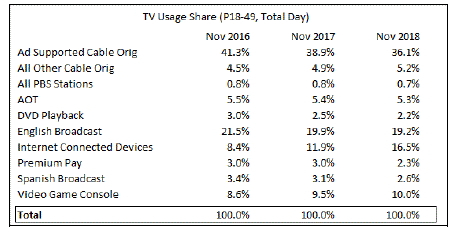Pivotal Research Group Senior Research Analyst for Advertising Brian Wieser and his team have analyzed trends associated with the use of television alongside commercial share trends for national media owners in the United States through the end of the calendar month of November 2018.
What did they find? Consumption of video programming through internet-connected devices continues to surge. What’s the verdict for broadcast TV?
“Most underlying trends are stable with flat (+0.2%) total TV consumption, 3.8% declines in consumption of TV among adults 18-49 and nearly double-digit declines in ad-supported national TV commercial impressions,” says Wieser, who regularly dismisses television as the worst possible form of advertising.
Then, there is the stability of growth of internet-connected devices, mainly content consumed by Roku, Apple TV, Chromecast and similar devices. Growth in November was at more than 40%.
This is notable, Wieser notes, considering that ICD-related consumption is now in excess of 16% of viewing for adults 18-49. That’s nearly double the level seen in November 2016.
At a network group level, commercial share trends were relatively positive for AMC, Disney, Fox and Viacom. On the contrary, the commercial share trends in November were negative for CBS, NBCUniversal and Warner Media.
Related trends were stable for Discovery.
Prime time trends were -4.2% for adults 18-49 while viewing was down during the daypart by -0.7% for households.
Looking at ad-supported cable and English-language broadcast networks only and among adults 18-49, a 10% decline during prime time is seen, along with a 9.5% decline on a total day basis.
Among households for the same ad-supported cable and English-language broadcast networks, Pivotal sees a 4% decline in viewing during prime time and a decline of 3% on a total day basis.

Source: Pivotal Research Analysis of Nielsen Data





